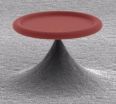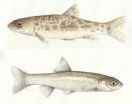(Press-News.org) Boston, Mass. - While it has become clear in recent years that susceptibility to pain has a strong inherited component, very little is known about actual "pain genes" and how they work. In the November 12th issue of Cell, researchers at Children's Hospital Boston and their collaborators report on a novel human pain gene. People with minor variations in this gene showed clear differences in susceptibility to acute heat pain and chronic back pain. Corroborating mouse studies give some clues as to how the gene controls pain sensitivity. The gene was uncovered in a genome-wide hunt for pain genes in fruit flies, which revealed hundreds of other candidate pain genes that await further study.
Understanding the genetic basis of pain will lead to the development of new analgesics, the identification of risk factors for chronic pain and improved decision-making about the suitability of surgical treatment for different patients, says Clifford Woolf, MB, BCh, PhD, the study's senior co-author and director of the F.M. Kirby Center and Program in Neurobiology at Children's.
Classic studies of twins indicate that about 50 percent of variance in pain sensitivity is inherited. "Across a number of different kinds of pain, genes seem to be at least half the driver of how much pain you experience," Woolf says. "Genes give us an amazing and powerful tool to begin to understand how pain is generated, and which functional pathways and specific proteins are involved."
The new gene, discovered in a collaboration with the Institute of Molecular Biotechnology of the Austrian Academy of Sciences and others, encodes part of a calcium channel called alpha 2 delta 3 (α2δ3). Calcium channels are pores in the cell membrane through which calcium ions pass, and are critical for the electrical excitability of nerve cells.
The study, co-led by Joseph Penninger, PhD, scientific director of the Institute of Molecular Biotechnology in Vienna, took advantage of the relative ease of conducting genetic screens in fruit flies. Nearly 12,000 genes were targeted for mutations specifically in nerve cells, using RNA interference (RNAi) technology. The team then exposed the different mutant flies to noxious heat, and identified the ones that failed to fly away. After eliminating flies with other complications, such as an inability to see or fly, they zeroed in on those with mutations that appeared to be specific to pain.
Of the nearly 600 candidate pain genes identified, α2δ3 was one chosen for further study, in part because calcium channels are a known target of some existing analgesics. (Another member of the α2δ family of calcium channels, α2δ1, is a target of gabapentin and pregablin, commonly prescribed for neuropathic pain.)
Studies of mice lacking α2δ3 demonstrated that this gene controls sensitivity to noxious heat in mammals as well as flies. Further, functional MRI imaging of the mutant mice revealed that α2δ3 controls the processing of thermal pain signals in the brain: the heat pain signal seems to arrive appropriately at the thalamus, an early processing center, but does not travel to higher order pain centers in the cortex. Instead, the MRI images showed a surprising cross-activation of vision, olfaction and hearing cortical areas. This cross-activation, or synesthesia, was noted with tactile stimulation in addition to the heat pain stimulus.
To determine the gene's role in human pain sensitivity, Michael Costigan, PhD, assistant professor at Children's, together with colleagues at the University of Pittsburgh and the University of North Carolina, looked at four single nucleotide polymorphisms (SNPs), or single-letter variations in the DNA code, within or close to the α2δ3 gene in 189 healthy volunteers. They found that certain less common SNPs were associated with reduced sensitivity to acute pain in a test administering a quick series of noxious heat pulses. Additional testing in 169 patients who had undergone surgery for pain caused by herniated vertebral discs revealed that patients with these less common SNPs were substantially less likely to have persisting chronic pain.
The international team plans further studies on the other pain genes identified in the fly screen. In a recent publication in the journal Brain, Costigan and Woolf identified the gene encoding the potassium ion channel subunit KCNS1 as another pain gene. Minor variations in KCNS1 accounted for differential sensitivity to chronic pain in five of six independent patient cohorts. These patients, 1359 in total, suffered from lumbar back pain, pain following limb amputation or sciatica. A SNP in KCNS1 also accounted for differences in acute pain sensitivity in healthy volunteers. Importantly, the SNP variant associated with a higher risk of pain is relatively common in the general population—present homozygously (in its strongest form) in about one in five people and heterozygously (in a less dominant form) in about one in two people.
In 2006, the Woolf laboratory identified the first pain sensitivity gene in humans, GCH1, which encodes an enzyme controlling the synthesis of a co-factor essential for production of certain neurotransmitters.
"We are trying now to use a panel of the pain genes we've found— α2δ3, KCNS1, GCH1 and others—to develop a genetic risk profile and then say, if you combine these polymorphisms you have a 60% chance of chronic pain after surgery, versus say, if you have another polymorphism mix, a 5% chance. This is another way to personalize medicine," Woolf says.
INFORMATION:
The study was funded by the National Institutes of Health, the Austrian Academy of Sciences, the European Research Council and other organizations. The co-first authors were G. Gregory Neely, PhD of the Institute of Molecular Biotechnology and Andreas Hess, PhD of the University of Erlangen-Nuremberg in Germany.
Children's Hospital Boston is home to the world's largest research enterprise based at a pediatric medical center, where its discoveries have benefited both children and adults since 1869. More than 1,100 scientists, including nine members of the National Academy of Sciences, 12 members of the Institute of Medicine and 13 members of the Howard Hughes Medical Institute comprise Children's research community. Founded as a 20-bed hospital for children, Children's Hospital Boston today is a 392-bed comprehensive center for pediatric and adolescent health care grounded in the values of excellence in patient care and sensitivity to the complex needs and diversity of children and families. Children's also is the primary pediatric teaching affiliate of Harvard Medical School. For more information about the hospital and its research visit: www.childrenshospital.org/newsroom.
Fruit flies lead scientists to new human pain gene
Minor variations in the gene are associated with different sensitivity to acute and chronic pain
2010-11-12
ELSE PRESS RELEASES FROM THIS DATE:
All-optical transistor
2010-11-12
Controlling and modulating the flow of light is essential in today's telecommunications-based society. Professor Tobias Kippenberg and his team in EPFL's Laboratory of Photonics and Quantum Measurements have discovered a novel way to couple light and vibrations. Using this discovery, they built a device in which a beam of light traveling through an optical microresonator could be controlled by a second, stronger light beam. The device thus acts like an optical transistor, in which one light beam influences the intensity of another.
Their optical microresonator has two ...
Having severe acne may increase suicide risk
2010-11-12
Individuals who suffer from severe acne are at an increased risk of attempting suicide, according to a paper published on bmj.com today.
The study also finds that an additional risk may be present during and up to one year after treatment with isotretinoin, a commonly prescribed drug for severe acne. However, the authors stress that this additional risk is most likely due to the acne itself, rather than the drug treatment.
Isotretinoin (commonly marketed as Roaccutane, Accutane, Amnesteem, Claravis, Clarus or Decutan) has been used to treat severe acne since the 1980s. ...
Thousands of turtles captured in Madagascar despite ban
2010-11-12
New research has revealed up to 16,000 endangered turtles are being caught each year by villagers in just one region of Madagascar, despite a government ban.
Researchers from the University of Exeter and Blue Ventures Conservation say the figure, thought to be a conservative estimate, is the first direct assessment of turtle exploitation on the island.
The study highlights the extent of small-scale fishing, traditionally very difficult to monitor, and could be vital in finding a way to sustainably manage turtle fishing in the region.
Dr Annette Broderick, from the ...
Study points to window of opportunity for successful autism therapy
2010-11-12
"The biggest surprise to me was that we could rescue the autistic phenotype [in the human cells] to something close to normal," said Alysson Muotri of the University of California San Diego.
The researchers made the discovery by first transforming adult cells taken from patients with Rett Syndrome into induced pluripotent stem cells (iPS cells) using an established cocktail. iPS cells look and act very much like embryonic stem cells.
Those stem cells were able to form functional neurons in cell culture. However, neurons derived from Rett Syndrome patients exhibited ...
A long history of pain: Study finds pain gene common to flies, mice and humans
2010-11-12
They show that one of those genes in particular has a long evolutionary history, as evidenced by the fact that it plays a role in pain sensing in flies, mice and humans. At least in mice, the newly described gene is also linked to a condition known in humans as synesthesia, in which one sensory experience triggers the perception of another sense.
"We found lots of new genes and pathways that have never been implicated in pain before," said Josef Penninger of the Institute of Molecular Biotechnology of the Austrian Academy of Sciences.
"From a helicopter view, this ...
23 percent of young people get into fights when they go out at night
2010-11-12
Night-time violence among young Spaniards is becoming ever more common, according to a research study carried out by the European Institute of Studies on Prevention. The study shows that 5.2% of young people carry weapons when they go out at night, 11.6% have been attacked or threatened, and 23% have got into a fight at some time.
"Reports about young people being attacked or injured in fights when they go out at night are becoming increasingly common", Amador Calafat, lead author of the study and a researcher at the European Institute of Studies on Prevention (IREFREA), ...
Invasive species -- the biggest threat to fish in the Mediterranean basin
2010-11-12
An international team led by the Forest Technology Centre of Catalonia has carried out the first large-scale study of the threats facing freshwater fish in the Mediterranean basin. Invasive species, along with over-exploitation of water resources, are the most important pressures, and those that expose fish to the greatest risk of extinction.
"The continental fish of the Mediterranean basin are one of the most threatened biological groups in the world", Miguel Clavero, lead author of the study and a researcher from the Landscape Ecology Group of the Forest Technology ...
Scientists at IRB Barcelona and BSC publish the world's largest video data bank of proteins
2010-11-12
After four years of conducting intensive calculations in the supercomputer MareNostrum at the Barcelona Supercomputing Center, scientists headed by Modesto Orozco at the Institute for Research in Biomedicine (IRB Barcelona) have presented the world's largest data base on protein motions. Called MoDEL, this new database holds more than 1,700 proteins and is partially accessible through Internet to researchers worldwide. MoDEL has been developed to study the basic biology of proteins and to accelerate and facilitate the design of new pharmaceutical agents.
"Nowadays we ...
UT professors find mixing business with politics pays off
2010-11-12
Now that the 2010 election is over, here is something to consider for the 2012 race: If you want to fatten your company's profits, contribute to a political campaign.
A study by two College of Business Administration professors at the University of Tennessee, Knoxville, found that when firms engage in corporate political activities, such as lobbying and making campaign contributions, they enjoy about 20 percent higher performance. The study, by Russell Crook and David Woehr, along with Sean Lux of the University of South Florida, entitled "Mixing Business with Politics: ...
Teens' take on bullying
2010-11-12
Both the bully and the victim's individual characteristics, rather than the wider social environment, explain why bullying occurs, according to Swedish teenagers. The new study, by Dr. Robert Thornberg and Sven Knutsen from Linköping University in Sweden, also shows that 42 percent of teenagers blamed the victim for the bullying. The study is published online in Springer's journal, Child & Youth Care Forum.
In one of the rare studies investigating young people's views on why bullying takes place in school, Thornberg and Knutsen explored how teenagers explain bullying ...
LAST 30 PRESS RELEASES:
Treasure trove of data on aging publicly accessible
Trees4Adapt project to address risks from climate change and biodiversity loss through tree-based solutions
Nature Communications study from the Lundquist Institute identifies molecular mechanism underlying peripartum cardiomyopathy
Pennington Biomedical’s Dr. Gang Hu appointed to NIH Reproductive, Perinatal and Pediatric Health Review Group
World-first project shows great promise to treat low eye pressure
New technique puts rendered fabric in the best light
Brain cancer digital twin predicts treatment outcomes
Cat disease challenges what scientists thought about coronaviruses
Paulson Family Foundation makes an additional $19 million donation to Hebrew University to fund a new building for electrical engineering. Together with its previous gift brings the total donation to
Canada–Estonia partnership advances community-centered clean energy
Sandia’s economic impact sets record for 17th consecutive year
Researchers uncover how tumors become resistant to promising p53-targeted therapy
Aligning games and sets in determining tennis matches
UOC research team develops method to evaluate apps for treating depression
Extreme heat waves disrupt honey bee thermoregulation and threaten colony survival
New brain study explains how binge drinking contributes to long-lasting negative feelings
The Food and Drug Administration’s regulation of mifepristone
Prescribing patterns of potentially inappropriate central nervous system-active medications in older adults
One in four older Americans with dementia prescribed risky brain-altering drugs despite safety warnings
Social media use and well-being across adolescent development
Child poverty trends by race and ethnicity in the U.S. from 2022 to 2025
Tissue repair slows in old age. These proteins speed it back up
Korea University Institute for Environmental Health completed an invited training to strengthen environmental health capacity for Karakalpakstan Medical Institute
Study offers evidence that racial bias is at play in overrepresentation of Black youth in Canadian child welfare systems
JMIR Publications’ JMIR Neurotechnology invites submissions on novel technological advances for neurological disorders
JACC issues inaugural report on state of US cardiovascular health
SwRI evaluates fire risks associated with solar panel installations
Discovery on how aggressive breast cancer controls protein production
A simple blood test can predict Crohn’s disease years before symptoms appear
FAU study reveals social, family and health factors behind teen bullying
[Press-News.org] Fruit flies lead scientists to new human pain geneMinor variations in the gene are associated with different sensitivity to acute and chronic pain



